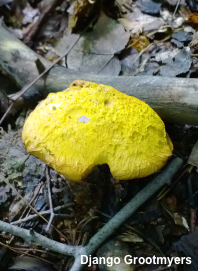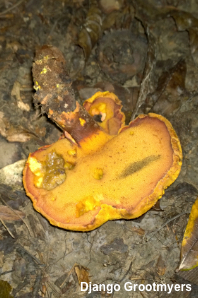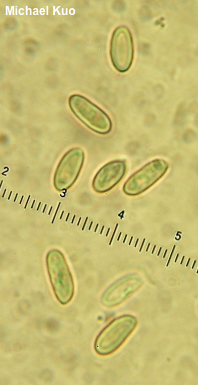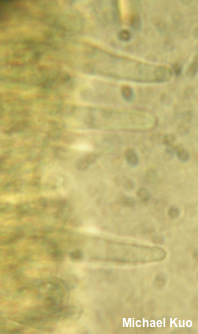| Major Groups > Boletes > "Boletus" | Red-Pored Boletes > Buchwaldoboletus hemichrysus |

|
Buchwaldoboletus hemichrysus [ Basidiomycota > Boletales > Boletaceae > Buchwaldoboletus . . . ] by Michael Kuo Known from the pine forests of the southeastern United States and Mexico, this odd bolete features a bright yellow cap that is covered with yellow powder, along with a reddish pore surface that begins to run down the stem, and a stem surface that is yellow and red. These are features delineated in the 1853 protologue (Berkeley & Curtis), citing a South Carolina collection that was "[a]ttached to roots of Pinus palustris." The genus Buchwaldoboletus (I call it "Where's-Waldo-Boletus") was created (Pilát 1969) to accommodate a few boletes that appeared to be saprobes, decomposing the wood of conifers. Most boletes are mycorrhizal, but these were consistently found growing from stumps and other deadwood; additionally, the mushrooms in question shared some morphological features, including a decurrent pore surface and yellow basal mycelium. If you are wondering why I said Buchwaldoboletus species "appeared" to be conifer-rotting saprobes, it's because the reality may be more complicated. Growing from wood, Buchwaldoboletus species certainly do not "act" like mycorrhizal mushrooms—but observations and several studies suggest Buchwaldoboletus lignicola may actually be parasitizing Phaeolus schweinitzii, which is saprobic on the pine wood. Interestingly, the collection of Buchwaldoboletus hemichrysus illustrated and described here was found with Phaeolus schweinitzii very nearby. In North America we may have three or more species of Buchwaldoboletus. Several of these species have been much confused over the years. Buchwaldoboletus hemichrysus, described here, has a bright yellow, powdery cap and a reddish pore surface. Buchwaldoboletus lignicola has a yellow-brown cap that is not powdery, and a yellow pore surface. Buchwaldoboletus sphaerocephalus (= "sulphureus") has a yellow, non-powdery cap as well as a yellow pore surface and stem. Rounding out the group is California's Boletus orovillus, with a non-powdery yellow cap, a yellow to reddish pore surface that does not run down the stem, and small, oddly non-bolete-like, ellipsoid spores. The latter species may or may not belong in Buchwaldoboletus. Contemporary DNA-based research has upheld the idea that Buchwaldoboletus is potentially a thing—but not with any rigor, since the "upholding" is almost exclusively based on two sequences from one poorly documented German collection of Buchwaldoboletus lignicola that may or may not actually exist in a herbarium somewhere, repeated over and over in publications that simply found the sequences in GenBank. (More recently, a few better-documented sequences of Chinese material have been used, as well.) Additionally, studies to date have struggled to articulate sufficient justification for separation of Buchwaldoboletus from Rubinoboletus and Chalciporus, which are very closely related. Boletus hemichrysus and Pulveroboletus hemichrysus are former names. Thanks to Django Grootmyers for documenting, collecting, and preserving Buchwaldoboletus hemichrysus for study; his collection is deposited in The Herbarium of Michael Kuo. Description: Ecology: Putatively saprobic on the wood and roots of pines (species in the genus Pinus, with bundled needles)—but see the discussion above regarding Phaeolus schweinitzii; growing alone, scattered, or gregariously; summer and fall; originally described from South Carolina; found throughout the southeastern United States, into Texas and Mexico. Records from Europe probably represent Buchwaldoboletus sphaerocephalus. The illustrated and described collection is from Kentucky. Cap: 6 cm (a single, mature specimen is described); broadly convex; dry; somewhat rugged; bright yellow; covered with fine yellow powder; the margin with a small, overhanging, sterile portion. Pore Surface: Beginning to run down the stem; reddish orange overall, but darker toward the margin; bruising blue; 1–2 angular pores per mm at maturity; tubes dull yellow, bruising olive blue, to 1 cm deep. Stem: 5.5 cm long; 1.5 cm thick; equal; very finely reticulate at the apex but smooth and bald elsewhere; yellow toward apex; brownish red below; basal mycelium bright sulphur yellow. Flesh: Yellow in stem; whitish in cap; bluing or turning pinkish when sliced; with a sub-gelatinous zone under the cap cuticle. Odor: Fruity. Microscopic Features: Spores 7–9.5 x 3–3.5 µm; elongated-ellipsoid; smooth; hyaline to faintly yellowish in KOH. Basidia 23 x 6 µm; clavate; 4-sterigmate; golden in KOH. Hymenial cystidia 32–45 x 4–5 µm; fusiform or narrowly lageniform; smooth; thin-walled; hyaline to yellowish in KOH. Pileipellis a tightly-packed cutis; elements 3–7 µm wide, smooth, thin-walled, yellow in KOH; exserted terminal cells cylindric with rounded, clavate, or nearly subcapitate apices. Contextual hyphae under the pileipellis gelatinized and poorly defined; 1–3 µm wide. Clamp connections not found. REFERENCES: (M. J. Berkeley & W. C. Curtis, 1853) A. Pilát, 1969. (Coker & Beers, 1943; Singer, 1947; Snell & Dick, 1970; Weber & Smith, 1985; Metzler & Metzler, 1992; Both, 1993; Bessette et al., 2002; Ortiz-Santana & Both, 2011; Bessette et al., 2016.) Herb. Kuo 10011601. This site contains no information about the edibility or toxicity of mushrooms. |
© MushroomExpert.Com |
|
Cite this page as: Kuo, M. (2021, March). Buchwaldoboletus hemichrysus. Retrieved from the MushroomExpert.Com Web site: http://www.mushroomexpert.com/buchwaldoboletus_hemichrysus.html |




